Spatial Analysis of the Vulnerability to Flooding in the Rural Context: The Case of the Emilia Romagna Region
Abstract
:1. Introduction
2. Materials and Methods
2.1. Mapping Approach
2.2. Step 1: Sensitivity
2.3. Step 2: Adaptive Capacity
2.4. Step 3: Vulnerability
3. Results
4. Discussion
- concerning the datasets used, a limited availability of uniform layers for the whole regional area (i.e., Saturated Hydraulic Conductivity that does not cover all the area) and a heterogeneity of the layers between different areas (i.e., Soil organic carbon, with a different definition between mountain and valley);
- lack of dynamism of some layers with respect to the real evolution of the territory (i.e., Corine Land Cover is made every 6 years);
- the inevitable approximation of reality, resulting from the use of a limited set of layers;
- absence of a socio-economic assessment of vulnerable elements within the methodology;
- consideration of water surfaces in the runoff model, such as rivers, as elements of vulnerability;
- an appropriate estimation of the weights of the individual layers considered for the assessment, appropriately declined according to the territorial context in which it is inserted, as [58].
- As far as agricultural policy is concerned, a process that produces this kind of result could be a very useful tool to better choose the areas that need the most support. In order to do this, the method and the relative results need to be adapted to the zonal characterizations that are used by Rural Development Plans to have a concrete and easy application.
- In the same way, the methodology discussed in this paper can become a tool that can make important additions to landscape planning tools such as the Regional Landscape Plan, particularly with respect to the higher degree of susceptibility associated with certain areas and can therefore support choices for the maintenance of certain landscapes in particular.
5. Conclusions
Author Contributions
Funding
Institutional Review Board Statement
Informed Consent Statement
Data Availability Statement
Acknowledgments
Conflicts of Interest
References
- Tripathi, A.; Tripathi, D.K.; Chauhan, D.K.; Kumar, N.; Singh, G.S. Paradigms of Climate Change Impacts on Some Major Food Sources of the World: A Review on Current Knowledge and Future Prospects. Agric. Ecosyst. Environ. 2016, 216, 356–373. [Google Scholar] [CrossRef]
- Hoegh-Guldberg, O.; Jacob, D.; Taylor, M.; Bindi, M.; Brown, S.; Camilloni, I.; Diedhiou, A.; Djalante, R.; Ebi, K.; Engelbrecht, F.; et al. Impacts of 1.5 °C Global Warming on Natural and Human Systems. In Global Warming of 1.5 °C. An IPCC Special Report on the Impacts of Global Warming of 1.5 °C above Pre-Industrial Levels and Related Global Greenhouse Gas Emission Pathways, in the Context of Strengthening the Global Response to the Threat of Climate Change, Sustainable Development, and Efforts to Eradicate Poverty; Masson-Delmotte, V., Zhai, P., Pörtner, H.O., Roberts, D., Skea, J., Shukla, P.R., Pirani, A., Moufouma-Okia, W., Péan, C., Pidcock, R., et al., Eds.; World Meteorological Organization Technical Document: Geneva, Switzerland, 2018; Volume 3, pp. 175–312. [Google Scholar] [CrossRef]
- Lucertini, G.; Di Giustino, G. Urban and Peri-Urban Agriculture as a Tool for Food Security and Climate Change Mitigation and Adaptation: The Case of Mestre. Sustainability 2021, 13, 5999. [Google Scholar] [CrossRef]
- Scazzosi, L. Rural Landscape as Heritage: Reasons for and Implications of Principles Concerning Rural Landscapes as Heritage ICOMOS-IFLA 2017. Built Herit. 2018, 2, 39–52. [Google Scholar] [CrossRef]
- Pachauri, R.K.; Allen, M.R.; Barros, V.R.; Broome, J.; Cramer, W.; Christ, R.; Church, J.A.; Clarke, L.; Dahe, Q.; Dasgupta, P.; et al. Contribution of Working Groups I, II and III to the Fifth Assessment Report of the Intergovernmental Panel on Climate Change. In Climate Change 2014: Synthesis Report; Pachauri, R., Meyer, L., Eds.; IPCC: Geneva, Switzerland, 2014; Volume 1, p. 53. ISBN 978-92-9169-143-2. [Google Scholar]
- Alexander, L.V. Global Observed Long-Term Changes in Temperature and Precipitation Extremes: A Review of Progress and Limitations in IPCC Assessments and Beyond. Weather. Clim. Extrem. 2016, 11, 4–16. [Google Scholar] [CrossRef] [Green Version]
- Nelson, D.R.; Adger, W.N.; Brown, K. Adaptation to Environmental Change: Contributions of a Resilience Framework. Annu. Rev. Environ. Resour. 2007, 32, 395–419. [Google Scholar] [CrossRef] [Green Version]
- Tompkins, E.L.; Adger, W.N. Does Adaptive Management of Natural Resources Enhance Resilience to Climate Change? Ecol. Soc. 2004, 9, 10–96. [Google Scholar] [CrossRef]
- Fischer, G.; Shah, M.; Tubiello, F.N.; van Velhuizen, H. Socio-Economic and Climate Change Impacts on Agriculture: An Integrated Assessment, 1990–2080. Philos. Trans. R. Soc. A 2005, 360, 2067–2083. [Google Scholar] [CrossRef]
- Cutter, S.L.; Mitchell, J.T.; Scott, M.S. Revealing the vulnerability of people and places: A case study of Georgetown County, South Carolina in Hazards Vulnerability and Environmental Justice, 1st ed.; Löfstedt, R.E., Ed.; Taylor & Francis: London, UK, 2006; pp. 111–142. ISBN 978-18-4977-154-2. [Google Scholar]
- Füssel, H.M.; Klein, R.J.T. Climate Change Vulnerability Assessments: An Evolution of Conceptual Thinking. Clim. Chang. 2006, 75, 301–329. [Google Scholar] [CrossRef]
- Maragno, D.; Dall’omo, C.F.; Pozzer, G.; Musco, F. Multi-Risk Climate Mapping for the Adaptation of the Venice Metro-politan Area. Sustainability 2021, 13, 1334. [Google Scholar] [CrossRef]
- Litt, G.; Ferraioli, E.; Magni, F.; Lucertini, G.; Musco, F. Inter-Municipal Methodology for Climate Transition Strategies: The First Case in Italy. Sustainability 2022, 14, 2529. [Google Scholar] [CrossRef]
- Manni, W. Travel Emilia Romagna: The Official Emilia Romagna’s Tourism Blog. Available online: https://www.travelemiliaromagna.it/en/tastes-emilia-romagna/ (accessed on 17 June 2022).
- Tomozeiu, R.; Lazzeri, M.; Cacciamani, C. Precipitation Fluctuations during the Winter Season from 1960 to 1995 over Emilia-Romagna, Italy. Theor. Appl. Climatol. 2002, 72, 221–229. [Google Scholar] [CrossRef]
- Brunetti, M.; Buffoni, L.; Maugeri, M.; Nanni, T. Precipitation intensity trends in northern Italy. Int. J. Climatol. 2000, 20, 1017–1031. [Google Scholar] [CrossRef]
- Ward, P.; de Ruiter, M.; Mård, J.; Schröter, K.; van Loon, A.; Veldkamp, T.I.E.; von Uexkull, N.; Wanders, N.; AghaKouchak, A.; Arnbjerg-Nielsen, K.; et al. The Need to Integrate Flood and Drought Disaster Risk Reduction Strategies. Water Secur. 2020, 11, 100070. [Google Scholar] [CrossRef]
- Alam, M.M.; bin Toriman, M.E.; Siwar, C.; Talib, B. Rainfall Variation and Changing Pattern of Agricultural Cycle. Am. J. Environ. Sci. 2011, 7, 82–89. [Google Scholar] [CrossRef]
- Bérubé, S.; Brissette, F.; Arsenault, R. Optymal hydrological model calibration strategy for climate change impact studies. J. Hydrol. Eng. 2022, 27, 3. [Google Scholar] [CrossRef]
- Witze, A. Why extreme rains are getting worse. Nature 2018, 563, 458–460. [Google Scholar] [CrossRef]
- Bortone, G.; Regione Emilia Romagna, Servizio Tutela E Risanamento Risorsa Acqua. La Gestione Sostenibile Delle Risorse Idriche in Emilia-Romagna. Available online: https://slideplayer.it/slide/537169/ (accessed on 13 July 2022).
- Aziz, O.; Hussain, S.; Rizwan, M.; Riaz, M.; Bashir, S.; Lin, L.; Mehmood, S.; Imran, M.; Yaseen, R.; Lu, G. Increasing Water Productivity, Nitrogen Economy, and Grain Yield of Rice by Water Saving Irrigation and Fertilizer-N Management. Environ. Sci. Pollut. Res. 2018, 25, 16601–16615. [Google Scholar] [CrossRef]
- Zhang, Y. Influence of Frequent Flood Disaster on Agricultural Productivity of Rice Planting and Structural Optimization Strategy. Microprocess. Microsyst. 2021, 82, 103863. [Google Scholar] [CrossRef]
- Domeneghetti, A.; Carisi, F.; Castellarin, A.; Brath, A. Evolution of flood risk over large areas: Quantitative assessment for the Po River. J. Hydrol. 2015, 527, 809–823. [Google Scholar] [CrossRef]
- Persiano, S.; Ferri, E.; Antolini, G.; Domeneghetti, A.; Pavan, V.; Castellarin, A. Changes in seasonality and magnitude of sub-daily rainfall extremes in Emilia-Romagna (Italy) and potential influence on regional rainfall frequency estimation. J. Hydrol. Reg. Stud. 2020, 32, 100751. [Google Scholar] [CrossRef]
- Brunetti, M.; Maugeri, M.; Nanni, T.; Navarra, A. Droughts and extreme events in regional daily Italian precipitation series. Int. J. Climatol. A J. Rouyal Metereological Soc. 2022, 22, 543–558. [Google Scholar] [CrossRef]
- Zeleňáková, M.; Purcz, P.; Hlavatá, H.; Engineering, P.B.-P. Climate Change in Urban versus Rural Areas. Procedia Eng. 2015, 119, 1171–1180. [Google Scholar] [CrossRef] [Green Version]
- European Commission Website. The New Common Agricultural Policy: 2023–2027. Available online: https://ec.europa.eu/info/food-farming-fisheries/key-policies/common-agricultural-policy/new-cap-2023-27_en (accessed on 21 June 2022).
- Regione Emilia-Romagna Statistica. Available online: https://statistica.regione.emilia-romagna.it/ (accessed on 16 April 2022).
- Centro Meteo. Il Clima Della Regione Emilia-Romagna. Available online: http://www.centrometeo.com/articoli-reportage-approfondimenti/climatologia/5423-clima-emiliaromagna#:~:text=dal%20mare%20adriatico%20all%27entroterra,solo%20lungo%20la%20fascia%20costiera (accessed on 11 January 2022).
- Regione Emilia-Romagna Geoportale. Coperture Vettoriali Uso Del Suolo Di Dettaglio–Edizione 2020. Available online: https://geoportale.regione.emilia-romagna.it/catalogo/dati-cartografici/pianificazione-e-catasto/uso-del-suolo/layer-9 (accessed on 16 June 2022).
- Sistema Nazionale Per La Protezione dell’Ambiente. Consumo Di Suolo, Dinamiche Territoriali E Servizi Ecosistemici. Edizione 2021. Available online: https://www.snpambiente.it/2021/07/14/consumo-di-suolo-dinamiche-territoriali-e-servizi-ecosistemici-edizione-2021/ (accessed on 20 February 2022).
- ARPAE Emilia-Romagna. Rapporti Idro-Meteo-Clima Annuali. Available online: https://www.arpae.it/it/temi-ambientali/meteo/report-meteo/rapporti-annuali (accessed on 20 February 2022).
- Below, T.B.; Schmid, J.; Sieber, S. Farmers’ Knowledge and Perception of Climatic Risks and Options for Climate Change Adaptation: A Case Study from Two Tanzanian Villages. Reg. Environ. Chang. 2014, 15, 1169–1180. [Google Scholar] [CrossRef]
- Kiem, A.S.; Austin, E.K. Drought and the Future of Rural Communities: Opportunities and Challenges for Climate Change Adaptation in Regional Victoria, Australia. Glob. Environ. Chang. 2013, 23, 1307–1316. [Google Scholar] [CrossRef] [Green Version]
- Savari, M.; Damaneh, H.E. Drought vulnerability assessment: Solution for risk alleviation and drought management among Iranian farmers. Int. J. Disaster Risk Reducti. 2022, 67, 102654. [Google Scholar] [CrossRef]
- Hazarika, N.; Barman, D.; Das, A.K.; Sarma, A.K.; Borah, S.B. Assessing and Mapping Flood Hazard, Vulnerability and Risk in the Upper Brahmaputra River Valley Using Stakeholders’ Knowledge and Multicriteria Evaluation (MCE). J. Flood Risk Manag. 2018, 11, S700–S716. [Google Scholar] [CrossRef]
- Rehman, A.; Song, J.; Haq, F.; Ahamad, M.I.; Sajid, M.; Zahid, Z. Geo-Physical Hazards Microzonation and Suitable Site Selection through Multicriteria Analysis Using Geographical Information System. Appl. Geogr. 2021, 135, 102550. [Google Scholar] [CrossRef]
- Wu, F.; Sun, Y.; Sun, Z.; Wu, S.; Zhang, Q. Assessing Agricultural System Vulnerability to Floods: A Hybrid Approach Using Emergy and a Landscape Fragmentation Index. Ecol. Indic. 2019, 105, 337–346. [Google Scholar] [CrossRef]
- Tate, E.; Rahman, M.A.; Emrich, C.T.; Sampson, C.C. Flood exposure and social vulnerability in the United States. Nat. Hazards 2021, 106, 435–457. [Google Scholar] [CrossRef]
- Ebert, A.; Kerle, N.; Stein, A. Urban Social Vulnerability Assessment with Physical Proxies and Spatial Metrics Derived from Air- and Spaceborne Imagery and GIS Data. Nat. Hazards 2009, 48, 275–294. [Google Scholar] [CrossRef]
- Alomar-Garau, G.; Grimalt-Gelabert, M. Air Photo Interpretation for Spatial Analysis of Heritage Agrarian Structures in Mediterranean Settings as Sea-Breezes Proxy-Data. Application to the Island of Mallorca. Remote Sens. 2021, 13, 4652. [Google Scholar] [CrossRef]
- Smith, C.G.; Jones, M.C.; Osterman, L.E.; Passeri, D.L. Using Multiple Environmental Proxies and Hydrodynamic Modelling to Investigate Late Holocene Climate and Coastal Change within a Large Gulf of Mexico Estuarine System (Mobile Bay, Alabama, USA). Mar. Geol. 2020, 427, 106218. [Google Scholar] [CrossRef]
- Fuhrer, J.; Gregory, P.J. Climate Change Impact and Adaptation in Agricultural Systems-Introduction. In Climate Change Impact and Adaptation in Agricultural Systems; Fuhrer, J., Gregory, P.J., Eds.; CABI Climate Change Series: Zurich, Switzerland, 2014; pp. 1–6. ISBN 9781780642895. [Google Scholar]
- Sharma, J.; Ravindranath, N.H. Applying IPCC 2014 Framework for Hazard-Specific Vulnerability Assessment under Climate Change. Environ. Res. Commun. 2019, 1, 51004. [Google Scholar] [CrossRef]
- Periyasamy, P.; Yagoub, M.M.; Sudalaimuthu, M. Flood Vulnerable Zones in the Rural Blocks of Thiruvallur District, South India. Geoenviron. Disasters 2018, 5, 21. [Google Scholar] [CrossRef]
- Munyai, R.B.; Chikoore, H.; Musyoki, A.; Chakwizira, J.; Muofhe, T.P.; Xulu, N.G.; Manyanya, T.C. Vulnerability and Adaptation to Flood Hazards in Rural Settlements of Limpopo Province, South Africa. Water 2021, 13, 3490. [Google Scholar] [CrossRef]
- Frischen, J.; Meza, I.; Rupp, D.; Wietler, K.; Hagenlocher, M. Drought Risk to Agricultural Systems in Zimbabwe: A Spatial Analysis of Hazard, Exposure, and Vulnerability. Sustainability 2020, 12, 752. [Google Scholar] [CrossRef] [Green Version]
- Regione Emilia-Romagna Geoportale. DTM 5x5. Available online: https://geoportale.regione.emilia-romagna.it/catalogo/dati-cartografici/altimetria/layer-2 (accessed on 20 February 2022).
- Regione Friuli Venezia Giulia. Regulation Containing Provisions for the Application of the Principle of Hydraulic In-Variance Referred to in Article 14, Paragraph 1, Letter k) of the Regional Law of Water Use. 29 April 2015. Available online: http://decreti.regione.fvg.it/Storage/2018_83/ALLEGATO1%20AL%20DPREG%20083-2018.PDF (accessed on 21 February 2022).
- Regione Emilia-Romagna Ambiente. Proprietà Fisico-Idrogeologiche Dei Suoli. Available online: https://ambiente.regione.emilia-romagna.it/it/geologia/suoli/proprieta-e-qualita-dei-suoli/proprieta-fisico-idrologiche-suoli (accessed on 10 February 2022).
- Tarocco, P.; Marchi, N.; Staffilani, F. Carta Della Conducibilità Idraulica Satura Dei Suoli Della Pianura Emiliano-Romagnola. Available online: http://mappegis.regione.emilia-romagna.it/gstatico/documenti/dati_pedol/ksat_pianura.pdf (accessed on 10 February 2022).
- Calzolari, C.; Ungaro, F.; Maienza, A.; Tarocco, P.; Marchi, N. SOS4LIFE, Linee Guida Per La Valutazione Dei Servizi Ecosistemici Dei Suoli In Ambito Urbano E Azioni Concrete Per La Loro Gestione. Available online: https://www.sos4life.it/wp-content/uploads/SOS4Life-Valutazione-servizi-ecosistemici-dei-suoli-in-ambito-urbano-e-azioni-per-la-loro-gestione_B.1.3-1.pdf (accessed on 10 February 2022).
- Ahmad, Q.K.; Anisimov, O.; Arnell, N.; Brown, S.; Burton, I.; Campos, M.; Canziani, O.; Carter, T.; Cohen, S.J.; Desanker, P.; et al. Summary for Policymakers. In Climate Change 2001: Impacts, Adaptation, and Vulnerability; McCarthy, J.J., Canziani, O.F., Leary, N.A., Dokken, D.J., White, K.S., Eds.; Cambridge University Press: Cambridge, UK, 2002; ISBN 0-521-80768-9. [Google Scholar] [CrossRef]
- EXEO edizioni, Caratteristiche Dei Terreni. Available online: https://www.exeo.it/faq/130/caratteristiche-terreni.aspx (accessed on 21 February 2022).
- Getahun, Y.S.; Gebre, S.L. Flood Hazard Assessment and Mapping of Flood Inundation Area of the Awash River Basin in Ethiopia Using GIS and HEC-GeoRAS/HEC-RAS Model. J. Civ. Environ. Eng. 2015, 5, 1. [Google Scholar] [CrossRef]
- Lucertini, G.; Di Giustino, G.; dall’Omo, C.F.; Musco, F. An innovative climate adaptation planning process: iDEAL project. J. Environ. Manag. 2022, 317, 115408. [Google Scholar] [CrossRef]
- Nguyen, B.; Minh, D.; Ahmad, A.; Nguyen, Q. The role of relative slope length in flood hazard mapping using AHP and GIS (case study: Lam River Basin, Vietnam). Geogr. Environ. Sustain. 2020, 13, 115–123. [Google Scholar] [CrossRef]
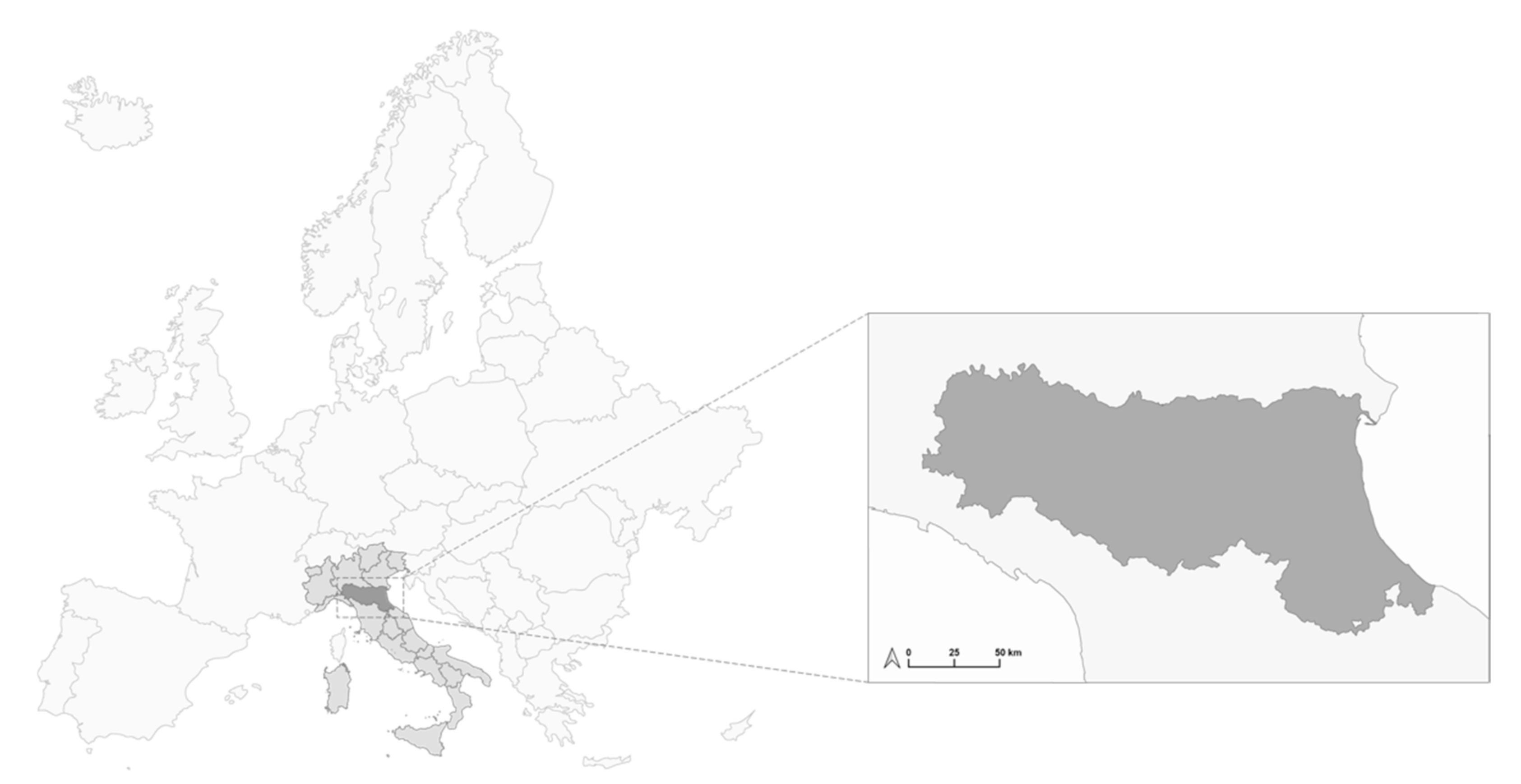
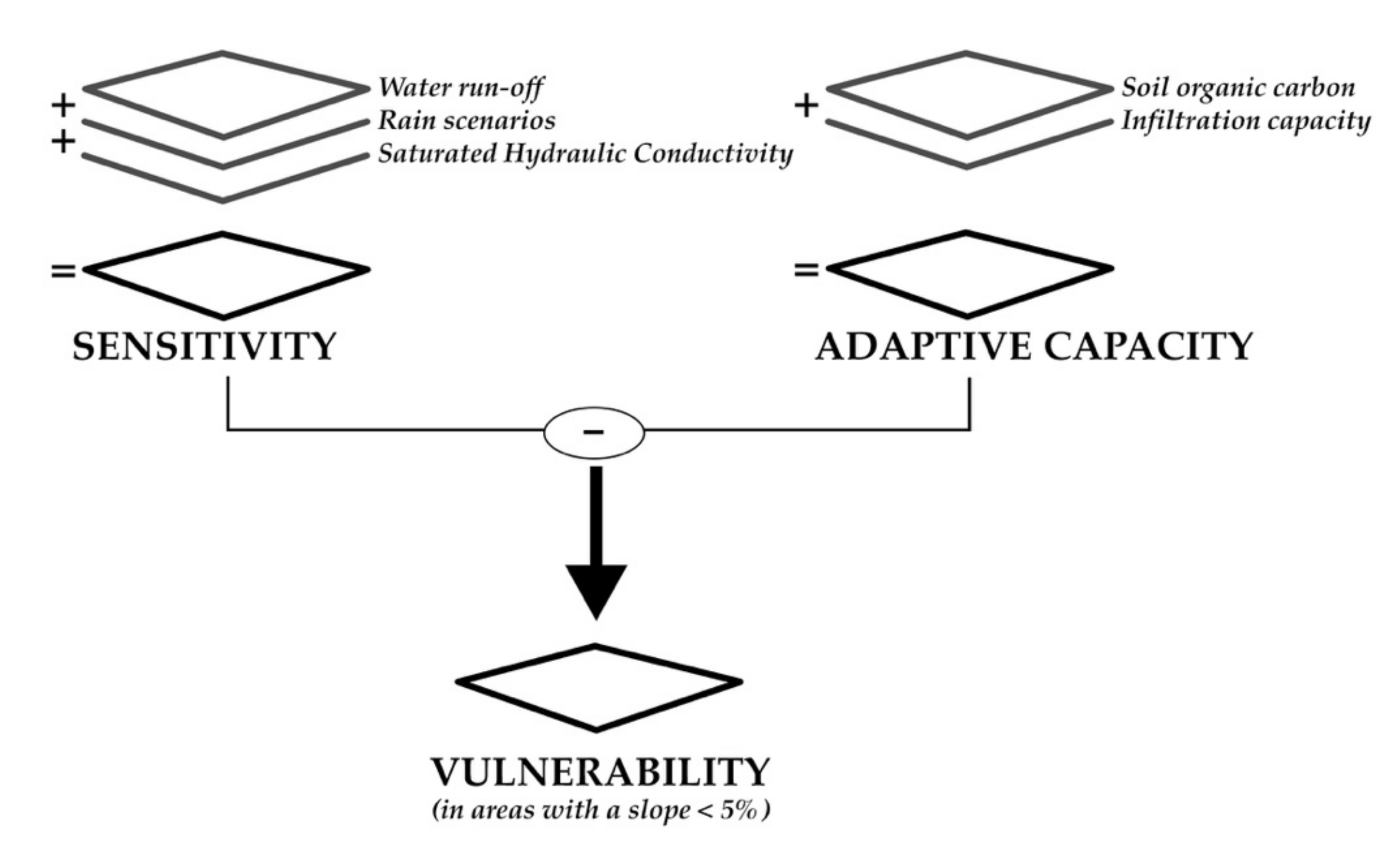
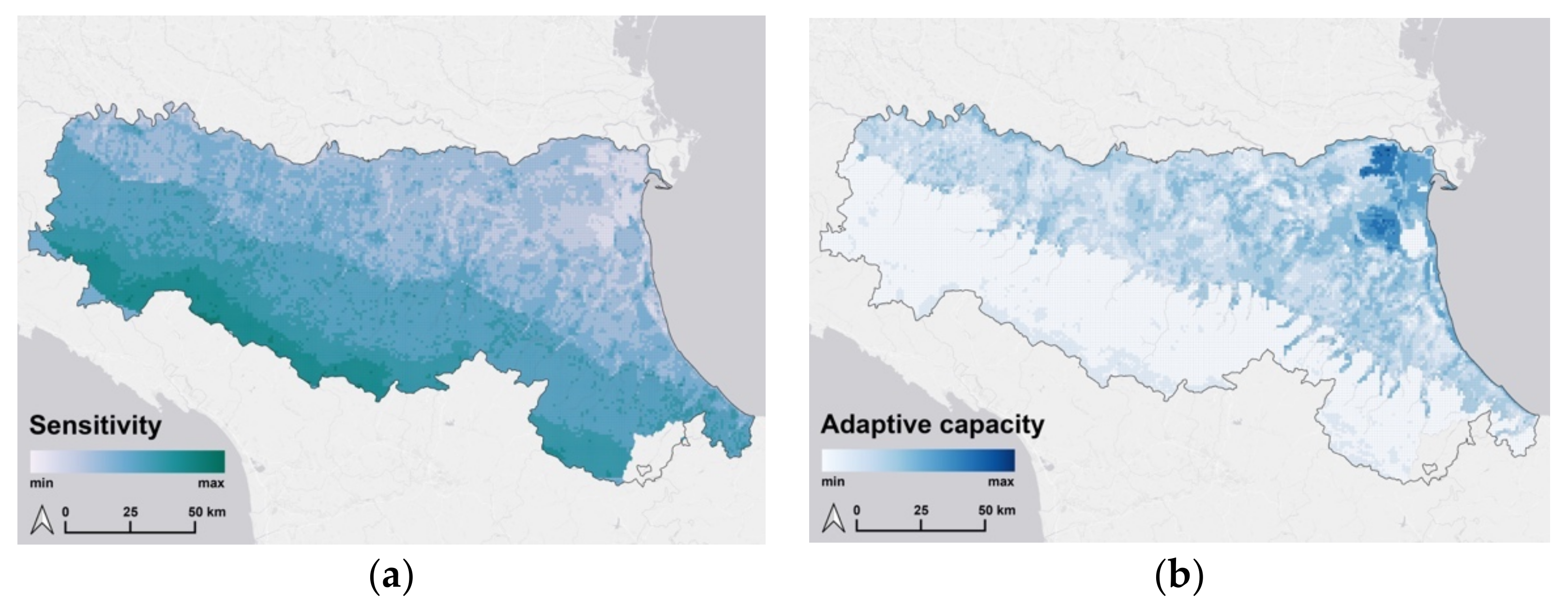
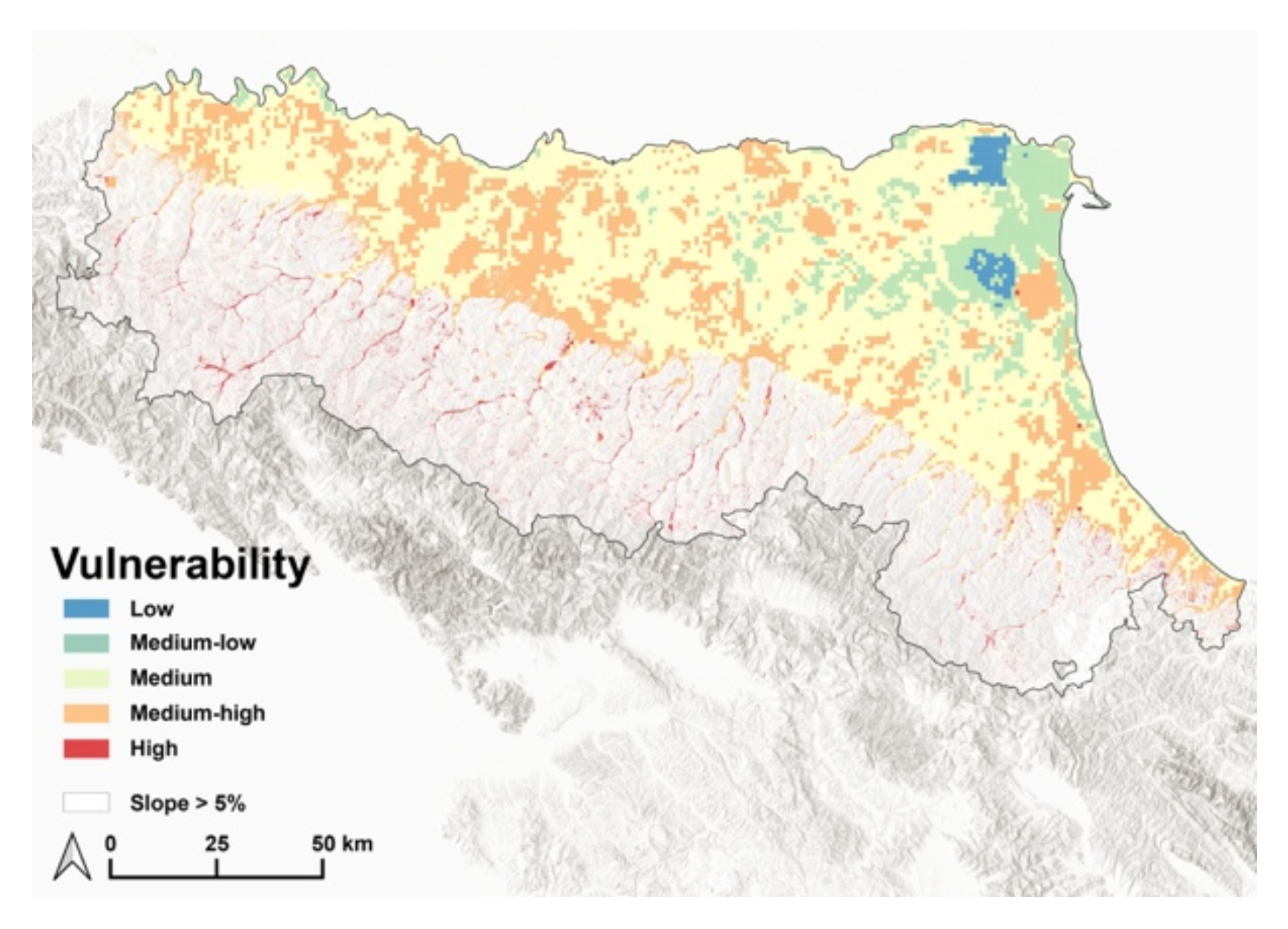
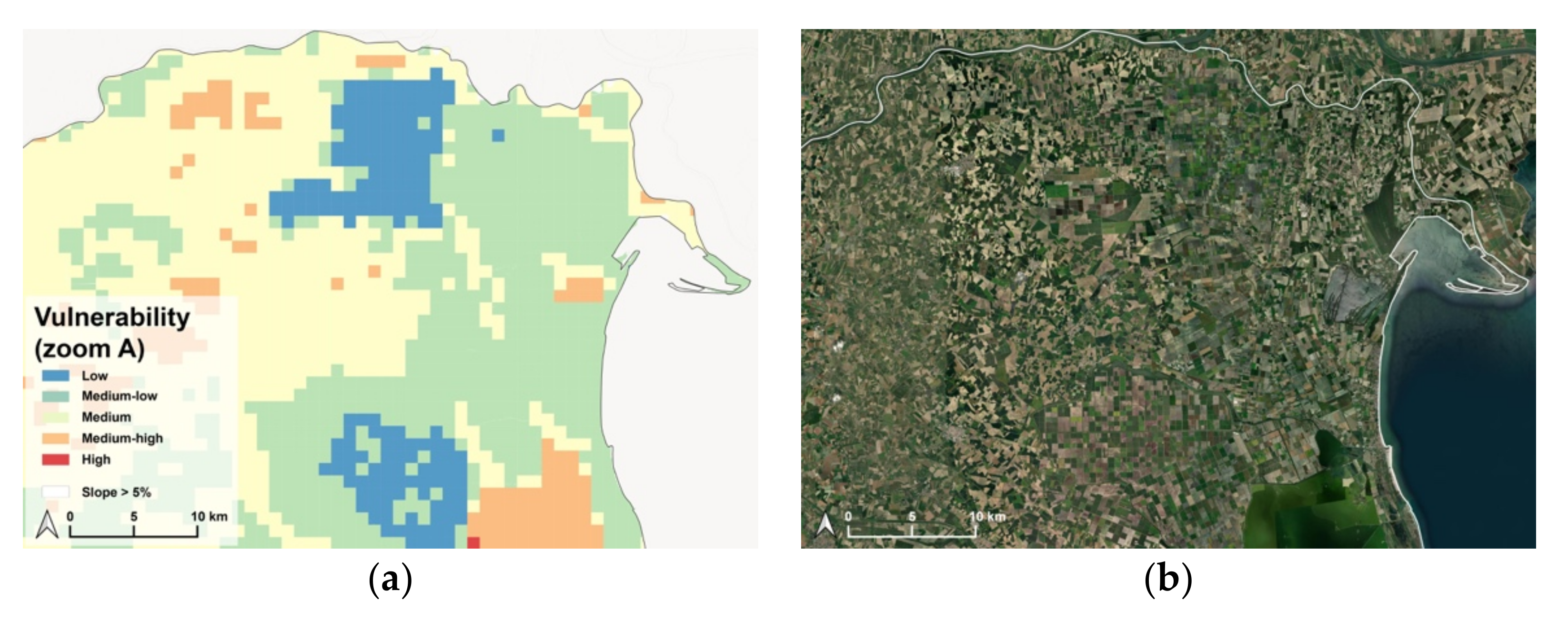
| Main factors | Layers | Description | Source * |
|---|---|---|---|
| Sensitive | (i) | Water run-off | DTM & CLC Emilia-Romagna Regional Geoportal |
| (ii) | Rain scenarios | ARPAE | |
| (iii) | Saturated hydraulic conductivity | Emilia-Romagna Regional Geoportal | |
| Adaptive capacity | (iv) | Soil organic carbon | Geological, Seismic and Soils Service—Emilia-Romagna Region |
| (v) | Infiltration capacity | “Portale MinERva” Emilia-Romagna Region |
| 3rd Level of Details of Land Use | Runoff Coefficients | |
|---|---|---|
| 1.1.1 | Continuous urban fabric | 0.80 |
| 1.1.2 | Discontinuous urban fabric | 0.75 |
| 1.2.1 | Industrial or commercial units | 0.80 |
| 1.2.2 | Road and rail networks and associated land | 0.85 |
| 1.2.3 | Port areas | 0.85 |
| 1.2.4 | Airports | 0.80 |
| 1.3.1 | Mineral extraction sites | 0.80 |
| 1.3.2 | Dump sites | 0.80 |
| 1.3.3 | Construction sites | 0.60 |
| 1.4.1 | Green urban areas | 0.30 |
| 1.4.2 | Sport and leisure facilities | 0.15 |
| 1.4.3 | Cemeteries | 0.20 |
| 2.1.1 | Non-irrigated arable land | 0.40 |
| 2.1.2 | Permanently irrigated land | 0.20 |
| 2.1.3 | Rice fields | 0.10 |
| 2.2.1 | Vineyards | 0.30 |
| 2.2.2 | Fruit trees and berry plantations | 0.30 |
| 2.2.3 | Olive groves | 0.30 |
| 2.2.4 | Other wood crops | 0.20 |
| 2.3.1 | Pastures | 0.30 |
| 2.4.1 | Annual crops associated with permanent crops | 0.40 |
| 2.4.2 | Complex cultivation patterns | 0.40 |
| 2.4.3 | Land principally occupied by agriculture | 0.40 |
| 3.1.1 | Broad-leaved forest | 0.20 |
| 3.1.2 | Coniferous forest | 0.20 |
| 3.1.3 | Mixed forest | 0.20 |
| 3.2.1 | Natural grasslands | 0.20 |
| 3.2.2 | Moors and heathland | 0.20 |
| 3.2.3 | Sclerophyllous vegetation | 0.20 |
| 3.3.1 | Beaches, dunes, sands | 0.20 |
| 3.3.2 | Bare rocks | 0.85 |
| 3.3.3 | Sparsely vegetated areas | 0.85 |
| 3.3.4 | Burnt areas | 0.30 |
| 4.1.1 | Inland marshes | 0.05 |
| 4.1.2 | Peat bogs | 0.05 |
| 4.2.1 | Salt marshes | 0.05 |
| 4.2.2 | Saline | 0.05 |
| 5.1.1 | Water courses | 0.05 |
| 5.1.2 | Water bodies | 0.05 |
| 5.2.1 | Coastal lagoons | 0.05 |
| Main Factors | Coverage | Description | Input File | Output File | Range Value |
|---|---|---|---|---|---|
| Water run-off | Total | DTM | Raster | Shapefile (areal) | 0–1 |
| Total | CLC | Shapefile | |||
| Rain scenarios | Total | Rain scenarios | csv | Shapefile (areal) | 0–1 |
| Saturated Hydraulic Conductivity | Partial | K-sat | Shapefile | Shapefile (areal) | 0–1 |
| Main Factors | Coverage | Description | Input File | Output File | Range Value |
|---|---|---|---|---|---|
| Soil organic carbon | Total | Organic carbon stored in soils 0–100 cm | Shapefile | Shapefile (areal) | 0–1 |
| Infiltration capacity | Partial | ES-WAR | Shapefile | Shapefile (areal) | 0–1 |
| Class of Vulnerability | Surface (ha) | Percentage of Total Vulnerability |
|---|---|---|
| Low | 23,826,927.66 | 1.31% |
| Medium low | 14,895,301.71 | 10.13% |
| Medium | 622,534,129.66 | 58.25% |
| Medium high | 300,093,104.27 | 28.08% |
| High | 107,328,925.87 | 2.23% |
| 1st Level of Detail of Land Use | Low | Medium-Low | Medium | Medium-High | High |
|---|---|---|---|---|---|
| Artificial surfaces | 1.14% | 12.69% | - | - | 9.38% |
| Agricultural areas | 97.72% | 62.51% | 86.39% | 83.56% | 54.31% |
| Forest and semi natural areas | 0.01% | 10.46% | 7.12% | 8.65% | 35.06% |
| Wetlands | - | 5.24% | 2.61% | 3.27% | - |
| Water bodies | 1.14% | 9.11% | 3.88% | 4.51% | 1.25% |
Publisher’s Note: MDPI stays neutral with regard to jurisdictional claims in published maps and institutional affiliations. |
© 2022 by the authors. Licensee MDPI, Basel, Switzerland. This article is an open access article distributed under the terms and conditions of the Creative Commons Attribution (CC BY) license (https://creativecommons.org/licenses/by/4.0/).
Share and Cite
Di Giustino, G.; Bonora, A.; Federico, K.; Reho, M.; Lucertini, G. Spatial Analysis of the Vulnerability to Flooding in the Rural Context: The Case of the Emilia Romagna Region. Atmosphere 2022, 13, 1181. https://doi.org/10.3390/atmos13081181
Di Giustino G, Bonora A, Federico K, Reho M, Lucertini G. Spatial Analysis of the Vulnerability to Flooding in the Rural Context: The Case of the Emilia Romagna Region. Atmosphere. 2022; 13(8):1181. https://doi.org/10.3390/atmos13081181
Chicago/Turabian StyleDi Giustino, Gianmarco, Alberto Bonora, Katia Federico, Matelda Reho, and Giulia Lucertini. 2022. "Spatial Analysis of the Vulnerability to Flooding in the Rural Context: The Case of the Emilia Romagna Region" Atmosphere 13, no. 8: 1181. https://doi.org/10.3390/atmos13081181
APA StyleDi Giustino, G., Bonora, A., Federico, K., Reho, M., & Lucertini, G. (2022). Spatial Analysis of the Vulnerability to Flooding in the Rural Context: The Case of the Emilia Romagna Region. Atmosphere, 13(8), 1181. https://doi.org/10.3390/atmos13081181







